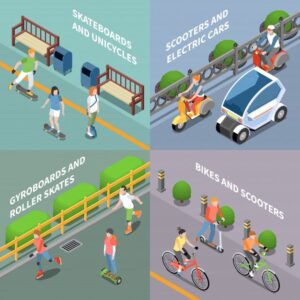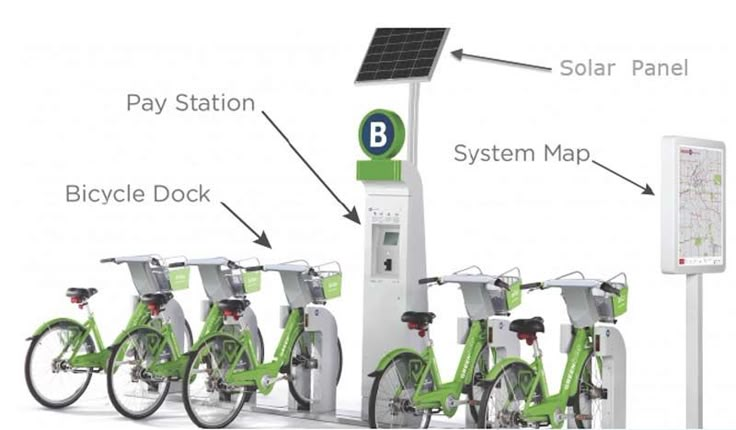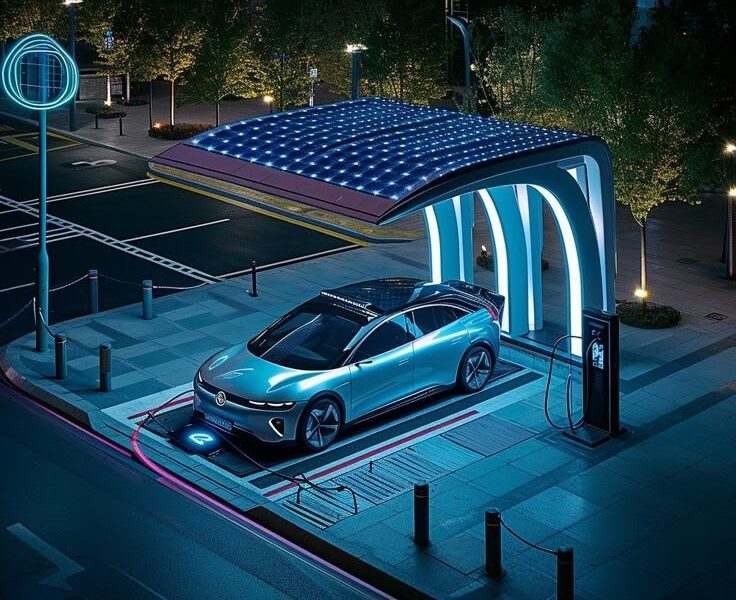### 🛵 **The Electric Two-Wheeler Revolution in Asia: A Solution for Dense Cities**
In Asia’s densely populated cities, electric two-wheelers have brought a revolutionary change to the transportation system, not only solving the problems of traditional traffic jams but also contributing to the reduction of environmental pollution. In China, the popularity of e-bikes and e-scooters has drastically transformed the urban transportation landscape, where these cheap, efficient, and eco-friendly means are facilitating the daily commute for millions of citizens. In India, electric rickshaws and motorcycles have not only created new employment opportunities but have also become a source of affordable transportation for the urban poor. In countries like Vietnam and Indonesia, electric motorcycles have rapidly gained popularity, where narrow alleys and congested routes pose difficulties for traditional cars. These electric two-wheelers not only save fuel costs but also have extremely low maintenance costs. Developments in charging infrastructure, such as battery swapping stations and fast charging points, have made using these vehicles even easier for consumers. Government incentives and subsidies have made electric two-wheelers financially attractive, leading to a continuous increase in their popularity. Urban planners have allocated dedicated lanes and parking facilities for electric two-wheelers, promoting their use. In addition to environmental benefits, these vehicles are also contributing to the reduction of urban noise, which is a major problem in dense cities. The trend of electric two-wheelers among the younger generation is particularly notable, seen as an expression of not only environmental protection but also a modern lifestyle. All these factors together are making electric two-wheelers a crucial pillar of urban transportation in Asia.

🚲 **European Micro-Mobility Models: Shaping Sustainable Urban Transport**
In the developed cities of Europe, micro-mobility solutions have set new standards for sustainable urban transport, where electric scooters, bicycles, and other light vehicles have become an important means of daily commute for citizens. In French cities, electric scooter sharing systems have complemented the public transport network, helping citizens with first-mile and last-mile connectivity. In the Netherlands, the popularity of electric bicycles has added a new dimension to the cycle-friendly culture, where they are not just for recreation but also a means of daily transport. In German cities, electric microcars have played a significant role in solving parking problems, as they occupy less space compared to traditional cars. The European Union’s strict emission regulations have promoted electric micro-mobility solutions, under which cities have established low-emission zones. Integration with public transport has increased the utility of micro-mobility solutions, where citizens use electric scooters and bicycles alongside buses, metros, and trains. Smart city initiatives have integrated micro-mobility solutions with digital platforms, providing users with real-time information and seamless payment options. Urban planning is prioritizing pedestrians and cyclists, making the use of micro-mobility solutions even more attractive. Dedicated bike lanes and scooter pathways in European cities have improved safety standards. Environmental awareness has encouraged citizens to adopt micro-mobility solutions. All these measures together are shaping a new model of sustainable transport in European cities.
🌍 **The Rise of Electric Mobility in Africa: A Source of Economic Development**
In Africa’s rapidly developing cities, electric two-wheelers and micro-mobility solutions have not only solved transportation problems but have also opened new doors for economic development. In countries like Kenya and Rwanda, electric motorcycles have revolutionized the public transportation system, being both cheap and reliable. In South African cities, electric scooter sharing services have provided alternative means of urban transport. Local manufacturing has promoted the domestic production of electric two-wheelers, creating new job opportunities. Solar-powered charging stations have made the use of electric vehicles possible in off-grid areas. Mobile payment systems have made the use of electric vehicles financially accessible. Entrepreneurship has formed new business models around electric mobility solutions. International aid organizations have provided funding for electric mobility projects in African countries. Government policies have promoted the in-country assembly of electric vehicles. Training programs have educated local technicians in the repair and maintenance of electric vehicles. All these developments are rapidly advancing the electric mobility sector in Africa on a path of growth.
🏙️ **The Promotion of Micro-Mobility in North America: The New Face of Urban Life**
In North American cities, micro-mobility solutions have challenged traditional concepts of urban life, where electric scooters, bicycles, and other light vehicles have become part of daily transport. In major US cities, electric scooter sharing companies have solved the last-mile connectivity problem. In Canadian cities, electric bicycles have gained popularity despite the harshness of winter. Urban planning departments have invested in micromobility infrastructure. Private sector investments have played a key role in the development of micromobility solutions. Technological innovation has introduced smart micromobility features. The insurance industry has offered specialized products for micromobility vehicles. Real estate developers have included charging infrastructure in properties. Corporate campuses have started employee micromobility programs. University campuses have adopted micromobility solutions for student mobility. The tourism industry has offered micromobility options for visitor mobility. All these factors together are shaping micromobility into a stable industry in North American cities.
🌆 **The Expansion of Electric Mobility in Latin America: Cultural Change**
In Latin American cities, electric two-wheelers have given rise to not only transportation but also cultural changes. In Brazilian cities, electric scooters have transformed daily commuting methods. In Mexico, electric motorcycles have revolutionized delivery services. In Colombian cities, electric bicycles have promoted a healthy lifestyle. In Argentina, electric microcars have created new opportunities for middle-class transportation. In Chile, electric public transport has improved the quality of urban transport. Local design and manufacturing have adapted electric vehicles to local needs. Cultural acceptance has made electric mobility solutions part of the local culture. Social enterprises have solved social issues through electric mobility. Community-based initiatives have promoted the use of electric mobility at the local level. All these changes are forming a new kind of urban mobility culture in Latin American cities.
🏗️ **Transformation of Urban Infrastructure: New Demands of Micro-Mobility**
The proliferation of micro-mobility solutions has demanded fundamental changes in the design and planning of urban infrastructure. Dedicated lanes for micromobility vehicles in street design have improved safety standards. Parking solutions have introduced the concept of compact parking spaces. Charging infrastructure has added new facilities in public spaces. Traffic management systems have been updated to include micromobility vehicles. Urban furniture has designed charging stations and parking racks. Public lighting has illuminated micromobility routes. Intersection design has ensured safe interaction between different types of vehicles. Wayfinding systems have made navigation easier for micromobility users. Public transportation hubs have provided facilities for micromobility integration. Land use planning has promoted the use of micromobility through mixed-use developments. All these infrastructure changes are making cities more conducive to micro-mobility.
📱 **Technology and Digitalization: Modern Dimensions of Micro-Mobility**
Technology and digitalization have given new dimensions to micro-mobility solutions, increasing their utility and accessibility. Mobile applications have simplified vehicle booking and payment processes. GPS tracking has enabled real-time monitoring of vehicle location. IoT sensors have collected data on vehicle health and usage patterns. AI algorithms have improved demand prediction and vehicle redistribution. Blockchain technology has provided secure transactions and data management. Augmented reality has enhanced navigation and user experience. Cloud computing has facilitated data storage and processing. Machine learning has enabled predictive maintenance. Digital platforms have made the integration of multiple mobility services possible. Smart charging systems have optimized energy management. All these technological advancements are making micro-mobility solutions smarter and more efficient.
🌱 **Environmental Impacts: Achieving Sustainable Urban Development**
The environmental impacts of electric two-wheelers and micro-mobility solutions have played a significant role in achieving sustainable urban development. Air quality improvement has enhanced urban health standards. Noise reduction has made the urban environment more peaceful. Energy efficiency has optimized energy use. Carbon emission reduction has lessened the effects of climate change. Resource conservation has aided in the protection of natural resources. Waste management has reduced the environmental impact of the vehicle lifecycle. Sustainable materials have made manufacturing processes eco-friendly. Circular economy approaches have made the product lifecycle sustainable. Environmental monitoring has confirmed the decrease in pollution levels. Climate resilience has strengthened cities against the effects of climate change. All these environmental benefits are making electric mobility solutions an important part of urban development.
💼 **Economic Changes: Creation of New Economic Opportunities**
Electric two-wheelers and micro-mobility solutions have created new opportunities through economic changes. Job creation has generated employment opportunities in manufacturing, maintenance, and operations sectors. Entrepreneurship has given birth to new business models. Cost savings have reduced transportation expenses for consumers. The local economy has boosted local industries. Export opportunities have opened new doors for international trade. Investment attraction has drawn foreign capital. The innovation ecosystem has established research and development centers. Skill development has enabled training in new skills. Economic inclusion has created opportunities for economically disadvantaged groups. Sustainable development has ensured long-term economic stability. All these economic changes are making the electric mobility industry an important source of economic development.
🔮 **Future Trends: A New Vision for Urban Transport**
The future trends of electric two-wheelers and micro-mobility solutions point towards a new vision for urban transport. Autonomous micromobility has introduced the concept of self-driving vehicles. Integrated mobility platforms have enabled the seamless integration of different transportation modes. Smart city integration has made micromobility an essential part of urban ecosystems. Advanced battery technology has increased performance and range. Vehicle-to-grid technology has created new opportunities for energy management. Personalized mobility services have catered to individual consumer needs. Sustainable urban planning has promoted compact city designs. Health and wellness features have made active transportation a healthy choice. Social equity initiatives have ensured transportation justice. Global standards have created international harmony. All these future trends point towards a bright future for urban transport.


